brake fluid INFINITI G-CONVERTIBLE 2011 Owners Manual
[x] Cancel search | Manufacturer: INFINITI, Model Year: 2011, Model line: G-CONVERTIBLE, Model: INFINITI G-CONVERTIBLE 2011Pages: 458, PDF Size: 3.83 MB
Page 17 of 458

VQ37VHR ENGINE
1. Fuse/fusible link holder (P. 8-20)
2. Battery (P. 8-13)
3. Engine oil filler cap (P. 8-8)
4. Brake fluid reservoir (P. 8-12)5. Clutch fluid reservoir
(Manual Transmission models) (P. 8-12)
6. Window washer fluid reservoir (P. 8-13)
7. Power steering fluid reservoir (P. 8-11)
8. Air cleaner (P. 8-17)
9. Radiator filler cap (P. 8-7) 10. Drive belts location (P. 8-16)
11. Engine Coolant reservoir (P. 8-7)
12. Engine oil dipstick (P. 8-8)
SSI0345
ENGINE COMPARTMENT
0-10Illustrated table of contents
Page 80 of 458
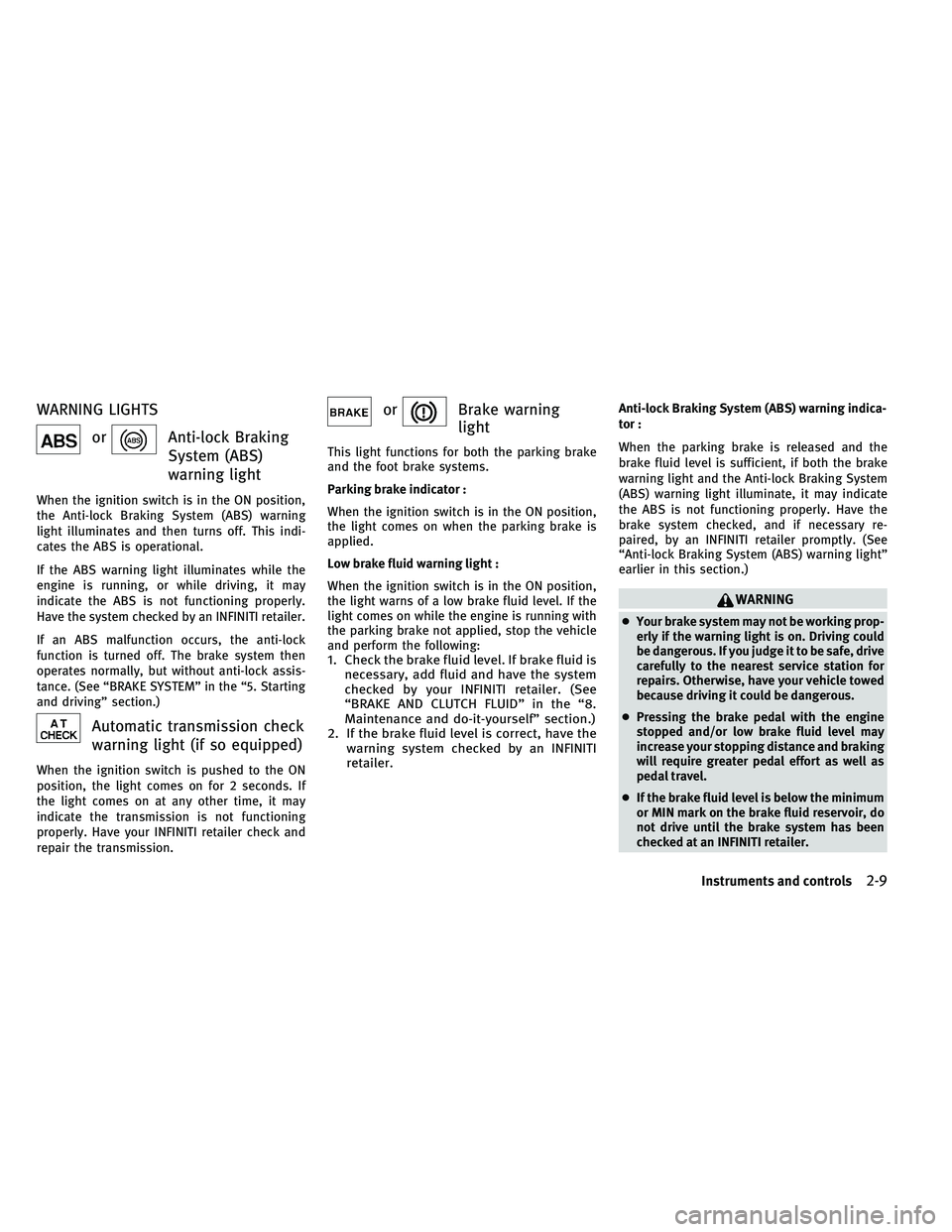
WARNING LIGHTS
orAnti-lock Braking
System (ABS)
warning light
When the ignition switch is in the ON position,
the Anti-lock Braking System (ABS) warning
light illuminates and then turns off. This indi-
cates the ABS is operational.
If the ABS warning light illuminates while the
engine is running, or while driving, it may
indicate the ABS is not functioning properly.
Have the system checked by an INFINITI retailer.
If an ABS malfunction occurs, the anti-lock
function is turned off. The brake system then
operates normally, but without anti-lock assis-
tance. (See “BRAKE SYSTEM” in the “5. Starting
and driving” section.)
Automatic transmission check
warning light (if so equipped)
When the ignition switch is pushed to the ON
position, the light comes on for 2 seconds. If
the light comes on at any other time, it may
indicate the transmission is not functioning
properly. Have your INFINITI retailer check and
repair the transmission.
orBrake warning
light
This light functions for both the parking brake
and the foot brake systems.
Parking brake indicator :
When the ignition switch is in the ON position,
the light comes on when the parking brake is
applied.
Low brake fluid warning light :
When the ignition switch is in the ON position,
the light warns of a low brake fluid level. If the
light comes on while the engine is running with
the parking brake not applied, stop the vehicle
and perform the following:
1. Check the brake fluid level. If brake fluid isnecessary, add fluid and have the system
checked by your INFINITI retailer. (See
“BRAKE AND CLUTCH FLUID” in the “8.
Maintenance and do-it-yourself” section.)
2. If the brake fluid level is correct, have the warning system checked by an INFINITI
retailer.
Anti-lock Braking System (ABS) warning indica-
tor :
When the parking brake is released and the
brake fluid level is sufficient, if both the brake
warning light and the Anti-lock Braking System
(ABS) warning light illuminate, it may indicate
the ABS is not functioning properly. Have the
brake system checked, and if necessary re-
paired, by an INFINITI retailer promptly. (See
“Anti-lock Braking System (ABS) warning light”
earlier in this section.)
WARNING
●Your brake system may not be working prop-
erly if the warning light is on. Driving could
be dangerous. If you judge it to be safe, drive
carefully to the nearest service station for
repairs. Otherwise, have your vehicle towed
because driving it could be dangerous.
● Pressing the brake pedal with the engine
stopped and/or low brake fluid level may
increase your stopping distance and braking
will require greater pedal effort as well as
pedal travel.
● If the brake fluid level is below the minimum
or MIN mark on the brake fluid reservoir, do
not drive until the brake system has been
checked at an INFINITI retailer.
Instruments and controls2-9
Page 83 of 458
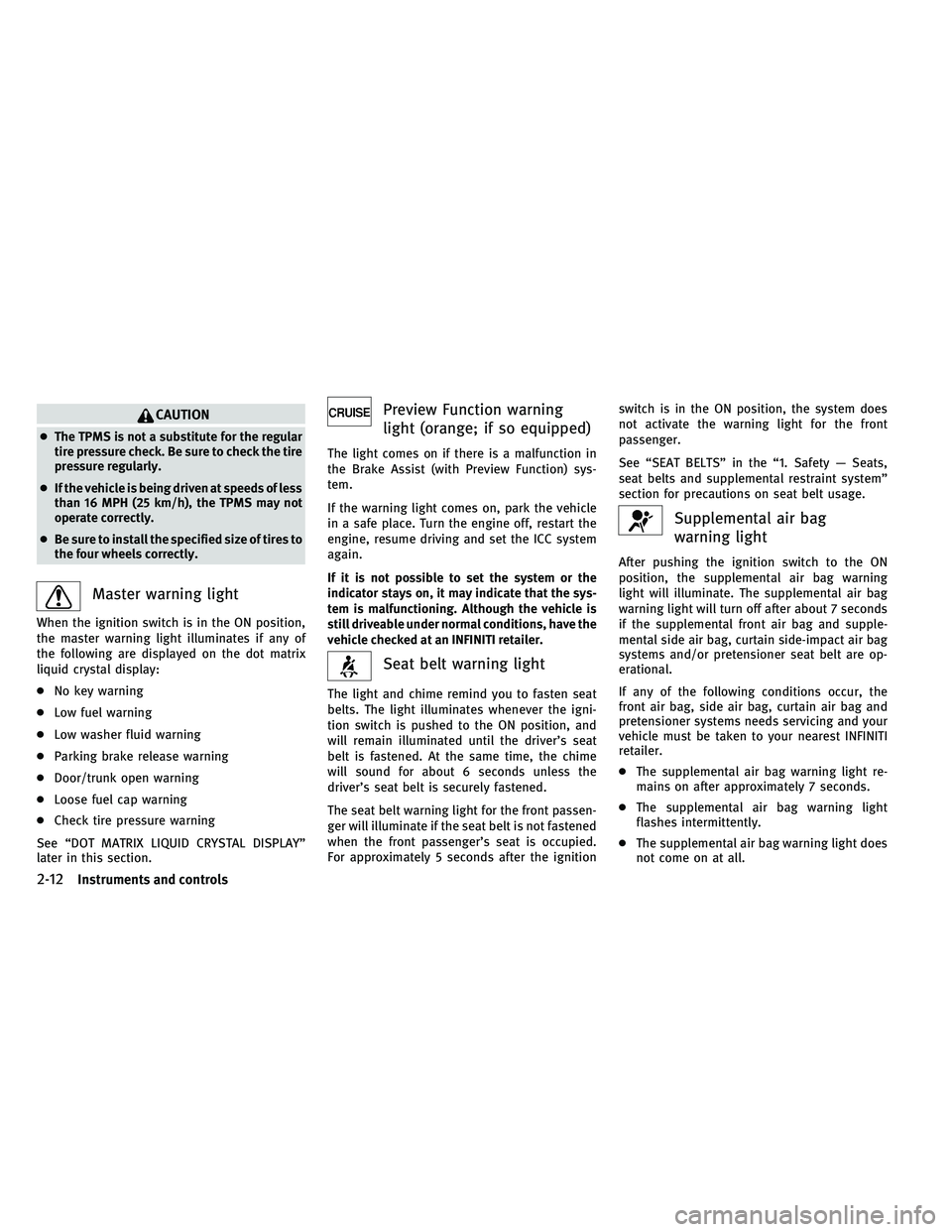
CAUTION
●The TPMS is not a substitute for the regular
tire pressure check. Be sure to check the tire
pressure regularly.
● If the vehicle is being driven at speeds of less
than 16 MPH (25 km/h), the TPMS may not
operate correctly.
● Be sure to install the specified size of tires to
the four wheels correctly.
Master warning light
When the ignition switch is in the ON position,
the master warning light illuminates if any of
the following are displayed on the dot matrix
liquid crystal display:
● No key warning
● Low fuel warning
● Low washer fluid warning
● Parking brake release warning
● Door/trunk open warning
● Loose fuel cap warning
● Check tire pressure warning
See “DOT MATRIX LIQUID CRYSTAL DISPLAY”
later in this section.
Preview Function warning
light (orange; if so equipped)
The light comes on if there is a malfunction in
the Brake Assist (with Preview Function) sys-
tem.
If the warning light comes on, park the vehicle
in a safe place. Turn the engine off, restart the
engine, resume driving and set the ICC system
again.
If it is not possible to set the system or the
indicator stays on, it may indicate that the sys-
tem is malfunctioning. Although the vehicle is
still driveable under normal conditions, have the
vehicle checked at an INFINITI retailer.
Seat belt warning light
The light and chime remind you to fasten seat
belts. The light illuminates whenever the igni-
tion switch is pushed to the ON position, and
will remain illuminated until the driver’s seat
belt is fastened. At the same time, the chime
will sound for about 6 seconds unless the
driver’s seat belt is securely fastened.
The seat belt warning light for the front passen-
ger will illuminate if the seat belt is not fastened
when the front passenger’s seat is occupied.
For approximately 5 seconds after the ignition switch is in the ON position, the system does
not activate the warning light for the front
passenger.
See “SEAT BELTS” in the “1. Safety — Seats,
seat belts and supplemental restraint system”
section for precautions on seat belt usage.
Supplemental air bag
warning light
After pushing the ignition switch to the ON
position, the supplemental air bag warning
light will illuminate. The supplemental air bag
warning light will turn off after about 7 seconds
if the supplemental front air bag and supple-
mental side air bag, curtain side-impact air bag
systems and/or pretensioner seat belt are op-
erational.
If any of the following conditions occur, the
front air bag, side air bag, curtain air bag and
pretensioner systems needs servicing and your
vehicle must be taken to your nearest INFINITI
retailer.
●
The supplemental air bag warning light re-
mains on after approximately 7 seconds.
● The supplemental air bag warning light
flashes intermittently.
● The supplemental air bag warning light does
not come on at all.
2-12Instruments and controls
Page 90 of 458
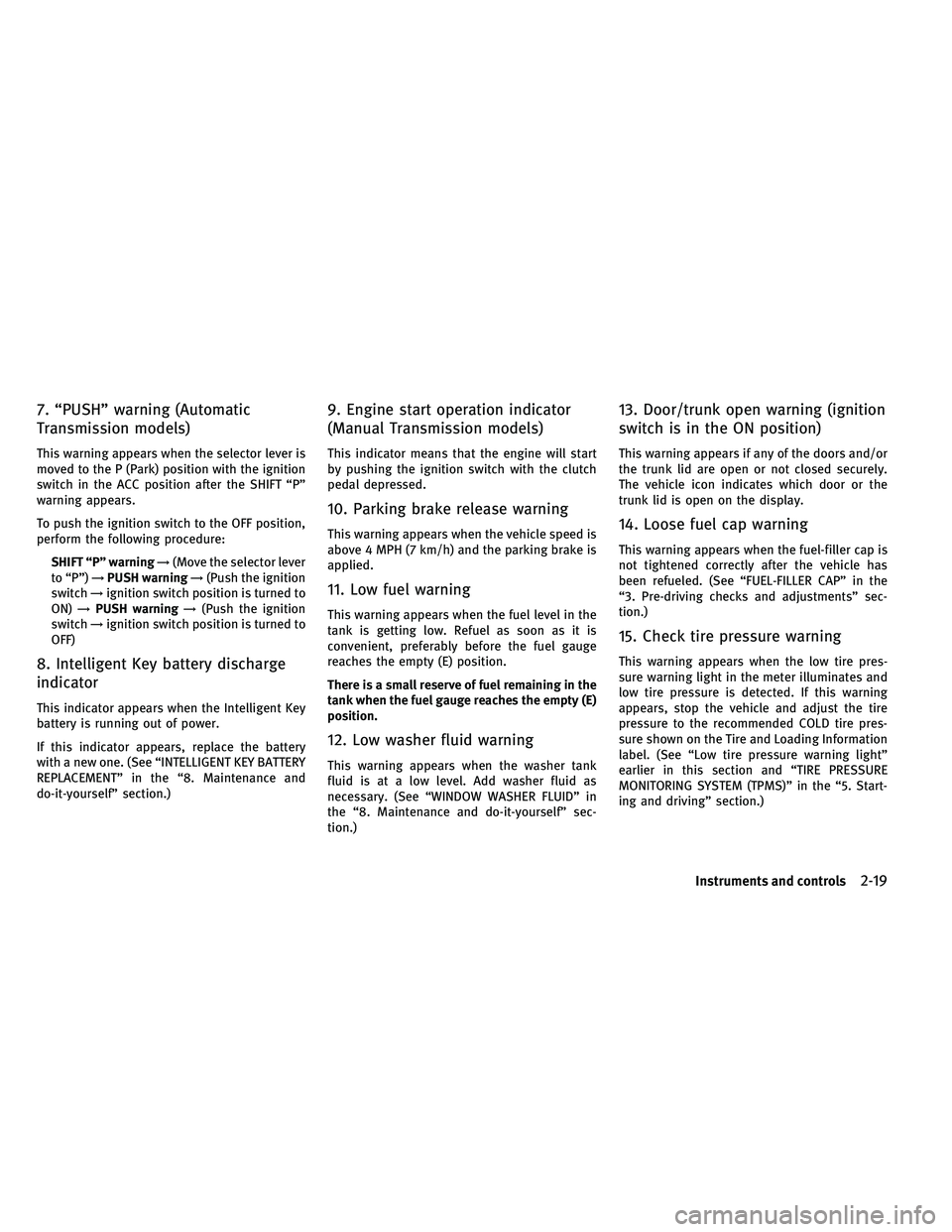
7. “PUSH” warning (Automatic
Transmission models)
This warning appears when the selector lever is
moved to the P (Park) position with the ignition
switch in the ACC position after the SHIFT “P”
warning appears.
To push the ignition switch to the OFF position,
perform the following procedure:SHIFT “P” warning →(Move the selector lever
to “P”) →PUSH warning →(Push the ignition
switch →ignition switch position is turned to
ON) →PUSH warning →(Push the ignition
switch →ignition switch position is turned to
OFF)
8. Intelligent Key battery discharge
indicator
This indicator appears when the Intelligent Key
battery is running out of power.
If this indicator appears, replace the battery
with a new one. (See “INTELLIGENT KEY BATTERY
REPLACEMENT” in the “8. Maintenance and
do-it-yourself” section.)
9. Engine start operation indicator
(Manual Transmission models)
This indicator means that the engine will start
by pushing the ignition switch with the clutch
pedal depressed.
10. Parking brake release warning
This warning appears when the vehicle speed is
above 4 MPH (7 km/h) and the parking brake is
applied.
11. Low fuel warning
This warning appears when the fuel level in the
tank is getting low. Refuel as soon as it is
convenient, preferably before the fuel gauge
reaches the empty (E) position.
There is a small reserve of fuel remaining in the
tank when the fuel gauge reaches the empty (E)
position.
12. Low washer fluid warning
This warning appears when the washer tank
fluid is at a low level. Add washer fluid as
necessary. (See “WINDOW WASHER FLUID” in
the “8. Maintenance and do-it-yourself” sec-
tion.)
13. Door/trunk open warning (ignition
switch is in the ON position)
This warning appears if any of the doors and/or
the trunk lid are open or not closed securely.
The vehicle icon indicates which door or the
trunk lid is open on the display.
14. Loose fuel cap warning
This warning appears when the fuel-filler cap is
not tightened correctly after the vehicle has
been refueled. (See “FUEL-FILLER CAP” in the
“3. Pre-driving checks and adjustments” sec-
tion.)
15. Check tire pressure warning
This warning appears when the low tire pres-
sure warning light in the meter illuminates and
low tire pressure is detected. If this warning
appears, stop the vehicle and adjust the tire
pressure to the recommended COLD tire pres-
sure shown on the Tire and Loading Information
label. (See “Low tire pressure warning light”
earlier in this section and “TIRE PRESSURE
MONITORING SYSTEM (TPMS)” in the “5. Start-
ing and driving” section.)
Instruments and controls2-19
Page 316 of 458
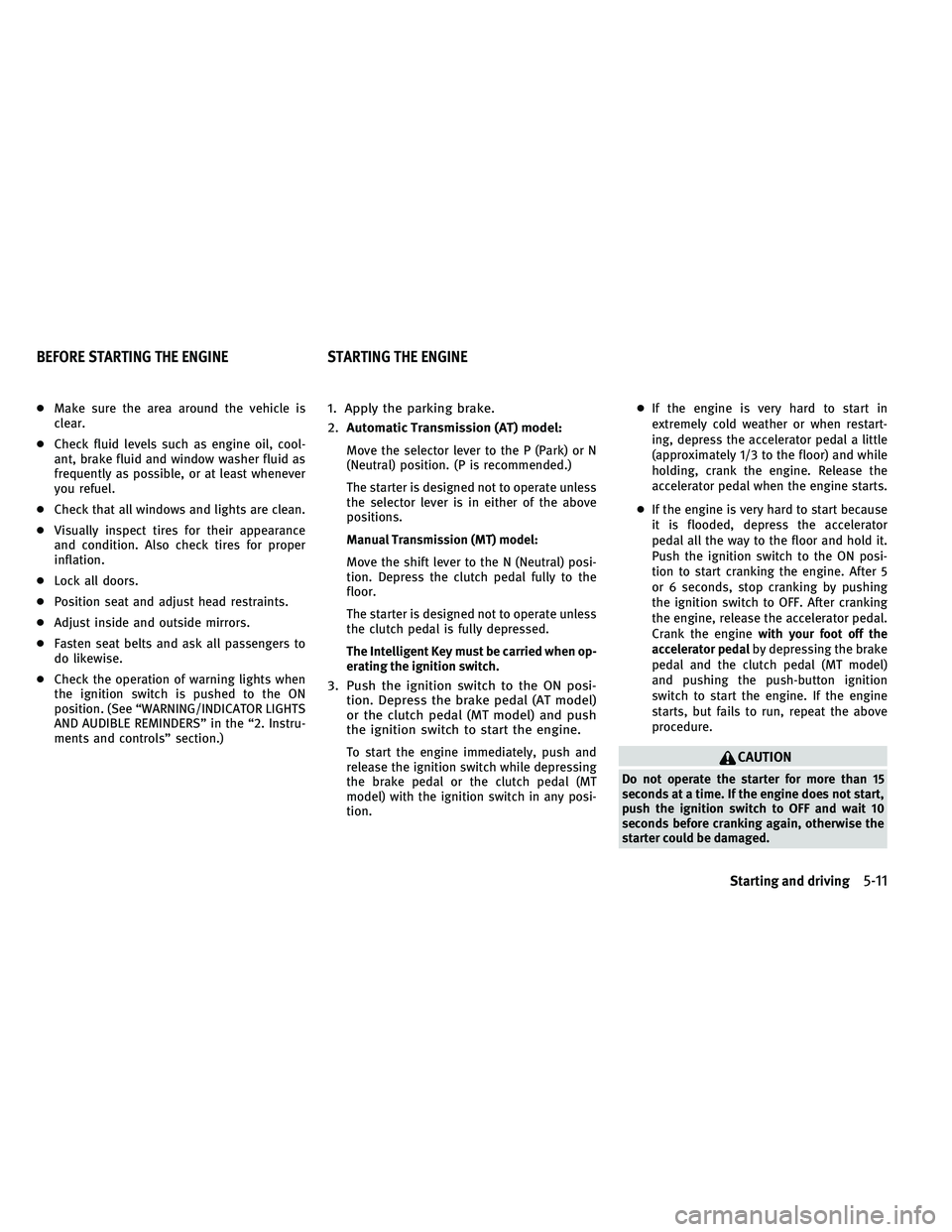
●Make sure the area around the vehicle is
clear.
● Check fluid levels such as engine oil, cool-
ant, brake fluid and window washer fluid as
frequently as possible, or at least whenever
you refuel.
● Check that all windows and lights are clean.
● Visually inspect tires for their appearance
and condition. Also check tires for proper
inflation.
● Lock all doors.
● Position seat and adjust head restraints.
● Adjust inside and outside mirrors.
● Fasten seat belts and ask all passengers to
do likewise.
● Check the operation of warning lights when
the ignition switch is pushed to the ON
position. (See “WARNING/INDICATOR LIGHTS
AND AUDIBLE REMINDERS” in the “2. Instru-
ments and controls” section.)1. Apply the parking brake.
2. Automatic Transmission (AT) model:
Move the selector lever to the P (Park) or N
(Neutral) position. (P is recommended.)
The starter is designed not to operate unless
the selector lever is in either of the above
positions.
Manual Transmission (MT) model:
Move the shift lever to the N (Neutral) posi-
tion. Depress the clutch pedal fully to the
floor.
The starter is designed not to operate unless
the clutch pedal is fully depressed.
The Intelligent Key must be carried when op-
erating the ignition switch.
3. Push the ignition switch to the ON posi-
tion. Depress the brake pedal (AT model)
or the clutch pedal (MT model) and push
the ignition switch to start the engine.
To start the engine immediately, push and
release the ignition switch while depressing
the brake pedal or the clutch pedal (MT
model) with the ignition switch in any posi-
tion. ●
If the engine is very hard to start in
extremely cold weather or when restart-
ing, depress the accelerator pedal a little
(approximately 1/3 to the floor) and while
holding, crank the engine. Release the
accelerator pedal when the engine starts.
● If the engine is very hard to start because
it is flooded, depress the accelerator
pedal all the way to the floor and hold it.
Push the ignition switch to the ON posi-
tion to start cranking the engine. After 5
or 6 seconds, stop cranking by pushing
the ignition switch to OFF. After cranking
the engine, release the accelerator pedal.
Crank the engine with your foot off the
accelerator pedal by depressing the brake
pedal and the clutch pedal (MT model)
and pushing the push-button ignition
switch to start the engine. If the engine
starts, but fails to run, repeat the above
procedure.CAUTION
Do not operate the starter for more than 15
seconds at a time. If the engine does not start,
push the ignition switch to OFF and wait 10
seconds before cranking again, otherwise the
starter could be damaged.
BEFORE STARTING THE ENGINE STARTING THE ENGINE
Starting and driving5-11
Page 356 of 458

How to handle the sensor
The sensor for the Preview Function is common
with Intelligent Cruise Control and is located
below the front bumper.
To keep the Preview Function operating prop-
erly, be sure to observe the following:
●Always keep the sensor clean. Wipe with a
soft cloth carefully so as not to damage the
sensor.
● Do not strike or damage the areas around
the sensor. Do not touch or remove the
screw located on the sensor. Doing so could
cause failure or malfunction. If the sensor is
damaged due to an accident, contact an
INFINITI retailer.
●
Do not attach a sticker (including transparent
material) or install an accessory near the sen-
sor. This could cause failure or malfunction.
ANTI-LOCK BRAKING SYSTEM (ABS)
WARNING
● The Anti-lock Braking System (ABS) is a so-
phisticated device, but it cannot prevent ac-
cidents resulting from careless or dangerous driving techniques. It can help maintain ve-
hicle control during braking on slippery sur-
faces. Remember that stopping distances on
slippery surfaces will be longer than on nor-
mal surfaces even with ABS. Stopping dis-
tances may also be longer on rough, gravel
or snow covered roads, or if you are using
tire chains. Always maintain a safe distance
from the vehicle in front of you. Ultimately,
the driver is responsible for safety.
● Tire type and condition may also affect brak-
ing effectiveness.
– When replacing tires, install the specified size of tires on all four wheels.
–
When installing a spare tire, make sure that
it is the proper size and type as specified on
the Tire and Loading Information label. See
“TIRE AND LOADING INFORMATION LABEL”
in the “9. Technical and consumer informa-
tion” section of this manual.
– For detailed information, see “WHEELS AND TIRES” in the “8. Maintenance and
do-it-yourself” section of this manual.
The Anti-lock Braking System (ABS) controls the
brakes so the wheels do not lock during hard
braking or when braking on slippery surfaces.
The system detects the rotation speed at each wheel and varies the brake fluid pressure to
prevent each wheel from locking and sliding. By
preventing each wheel from locking, the system
helps the driver maintain steering control and
helps to minimize swerving and spinning on
slippery surfaces.
Using the system
Depress the brake pedal and hold it down.
Depress the brake pedal with firm steady pres-
sure, but do not pump the brakes. The ABS will
operate to prevent the wheels from locking up.
Steer the vehicle to avoid obstacles.
WARNING
Do not pump the brake pedal. Doing so may
result in increased stopping distances.
Self-test feature
The ABS includes electronic sensors, electric
pumps, hydraulic solenoids and a computer.
The computer has a built-in diagnostic feature
that tests the system each time you start the
engine and move the vehicle at a low speed in
forward or reverse. When the self-test occurs,
you may hear a “clunk” noise and/or feel a
pulsation in the brake pedal. This is normal and
does not indicate a malfunction. If the computer
senses a malfunction, it switches the ABS off
Starting and driving5-51
Page 390 of 458
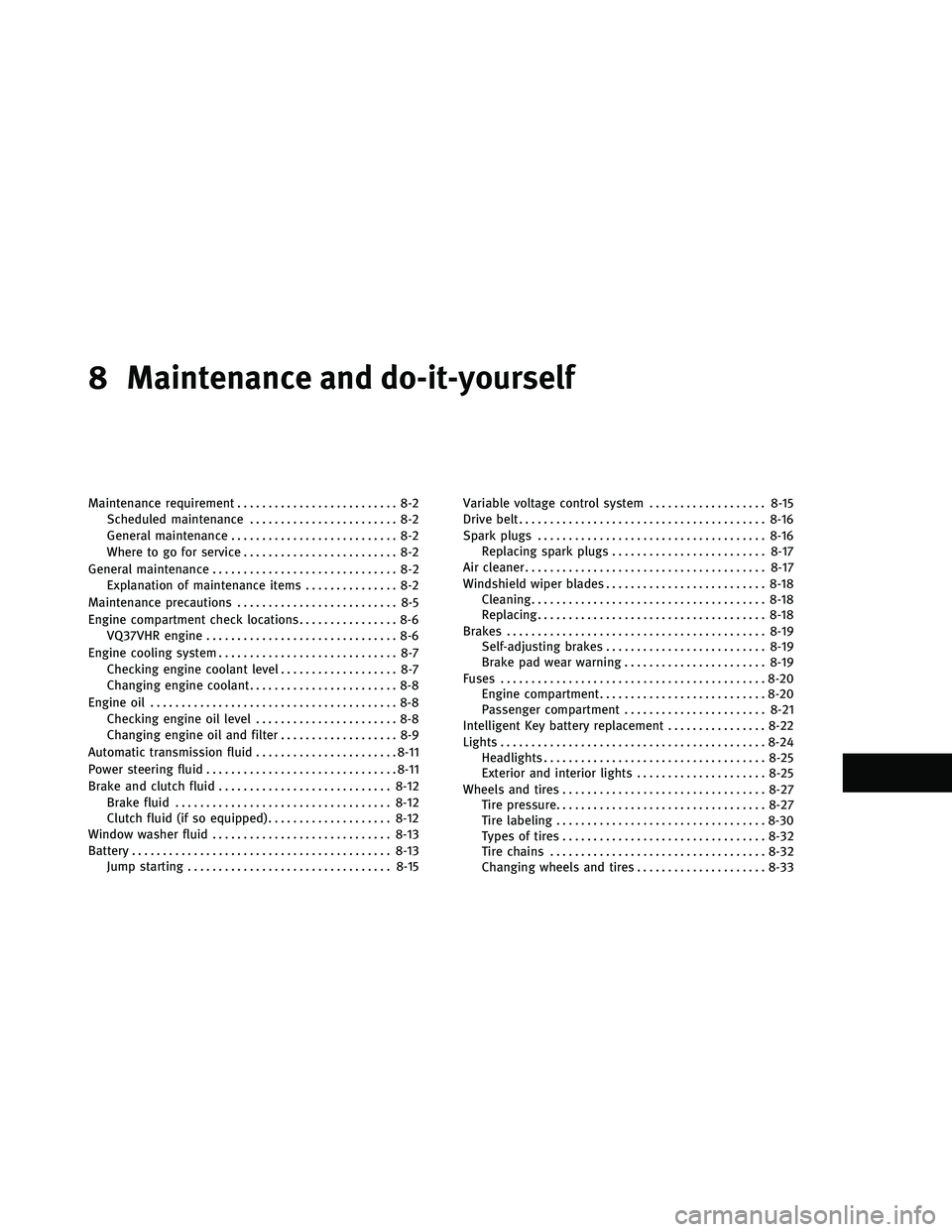
8 Maintenance and do-it-yourself
Maintenance requirement.......................... 8-2
Scheduled maintenance ........................ 8-2
General maintenance ........................... 8-2
Where to go for service ......................... 8-2
General maintenance .............................. 8-2
Explanation of maintenance items ............... 8-2
Maintenance precautions .......................... 8-5
Engine compartment check locations ................ 8-6
VQ37VHR engine ............................... 8-6
Engine cooling system ............................. 8-7
Checking engine coolant level ................... 8-7
Changing engine coolant ........................ 8-8
Engine oil ........................................ 8-8
Checking engine oil level ....................... 8-8
Changing engine oil and filter ................... 8-9
Automatic transmission fluid .......................8-11
Power steering fluid ............................... 8-11
Brake and clutch fluid ............................ 8-12
Brake fluid ................................... 8-12
Clutch fluid (if so equipped) ....................8-12
Window washer fluid ............................. 8-13
Battery .......................................... 8-13
Jump starting ................................. 8-15Variable voltage control system
...................8-15
Drive belt ........................................ 8-16
Spark plugs ..................................... 8-16
Replacing spark plugs ......................... 8-17
Air cleaner ....................................... 8-17
Windshield wiper blades .......................... 8-18
Cleaning ...................................... 8-18
Replacing ..................................... 8-18
Brakes .......................................... 8-19
Self-adjusting brakes .......................... 8-19
Brake pad wear warning ....................... 8-19
Fuses ........................................... 8-20
Engine compartment ........................... 8-20
Passenger compartment ....................... 8-21
Intelligent Key battery replacement ................8-22
Lights ........................................... 8-24
Headlights .................................... 8-25
Exterior
and interior lights ..................... 8-25
Wheels and tires ................................. 8-27
Tire pressure .................................. 8-27
Tire labeling .................................. 8-30
Types of tires ................................. 8-32
Tire chains ................................... 8-32
Changing wheels and tires..................... 8-33
Page 393 of 458
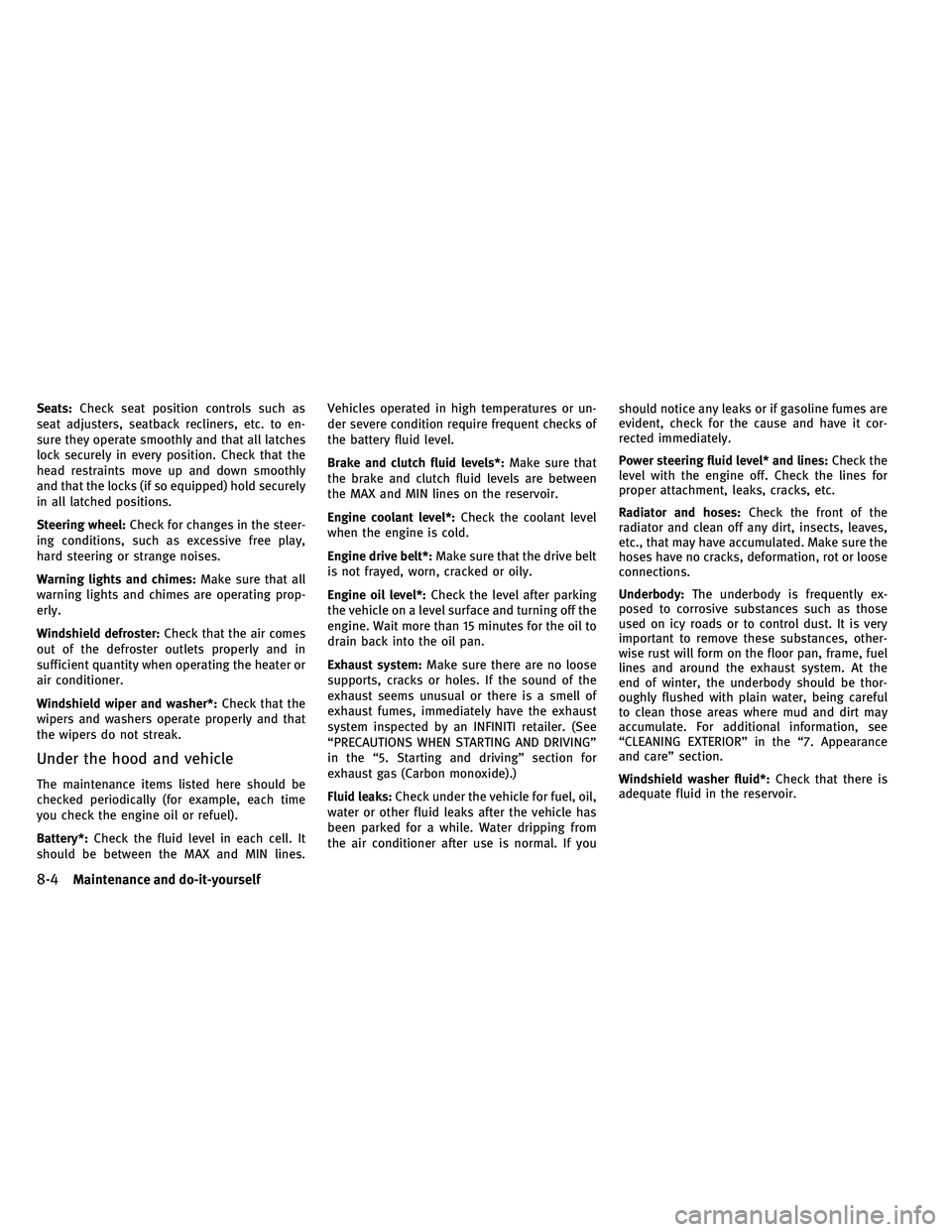
Seats:Check seat position controls such as
seat adjusters, seatback recliners, etc. to en-
sure they operate smoothly and that all latches
lock securely in every position. Check that the
head restraints move up and down smoothly
and that the locks (if so equipped) hold securely
in all latched positions.
Steering wheel: Check for changes in the steer-
ing conditions, such as excessive free play,
hard steering or strange noises.
Warning lights and chimes: Make sure that all
warning lights and chimes are operating prop-
erly.
Windshield defroster: Check that the air comes
out of the defroster outlets properly and in
sufficient quantity when operating the heater or
air conditioner.
Windshield wiper and washer*: Check that the
wipers and washers operate properly and that
the wipers do not streak.
Under the hood and vehicle
The maintenance items listed here should be
checked periodically (for example, each time
you check the engine oil or refuel).
Battery*: Check the fluid level in each cell. It
should be between the MAX and MIN lines. Vehicles operated in high temperatures or un-
der severe condition require frequent checks of
the battery fluid level.
Brake and clutch fluid levels*:
Make sure that
the brake and clutch fluid levels are between
the MAX and MIN lines on the reservoir.
Engine coolant level*: Check the coolant level
when the engine is cold.
Engine drive belt*: Make sure that the drive belt
is not frayed, worn, cracked or oily.
Engine oil level*: Check the level after parking
the vehicle on a level surface and turning off the
engine. Wait more than 15 minutes for the oil to
drain back into the oil pan.
Exhaust system: Make sure there are no loose
supports, cracks or holes. If the sound of the
exhaust seems unusual or there is a smell of
exhaust fumes, immediately have the exhaust
system inspected by an INFINITI retailer. (See
“PRECAUTIONS WHEN STARTING AND DRIVING”
in the “5. Starting and driving” section for
exhaust gas (Carbon monoxide).)
Fluid leaks: Check under the vehicle for fuel, oil,
water or other fluid leaks after the vehicle has
been parked for a while. Water dripping from
the air conditioner after use is normal. If you should notice any leaks or if gasoline fumes are
evident, check for the cause and have it cor-
rected immediately.
Power steering fluid level* and lines:
Check the
level with the engine off. Check the lines for
proper attachment, leaks, cracks, etc.
Radiator and hoses: Check the front of the
radiator and clean off any dirt, insects, leaves,
etc., that may have accumulated. Make sure the
hoses have no cracks, deformation, rot or loose
connections.
Underbody: The underbody is frequently ex-
posed to corrosive substances such as those
used on icy roads or to control dust. It is very
important to remove these substances, other-
wise rust will form on the floor pan, frame, fuel
lines and around the exhaust system. At the
end of winter, the underbody should be thor-
oughly flushed with plain water, being careful
to clean those areas where mud and dirt may
accumulate. For additional information, see
“CLEANING EXTERIOR” in the “7. Appearance
and care” section.
Windshield washer fluid*: Check that there is
adequate fluid in the reservoir.
8-4Maintenance and do-it-yourself
Page 394 of 458
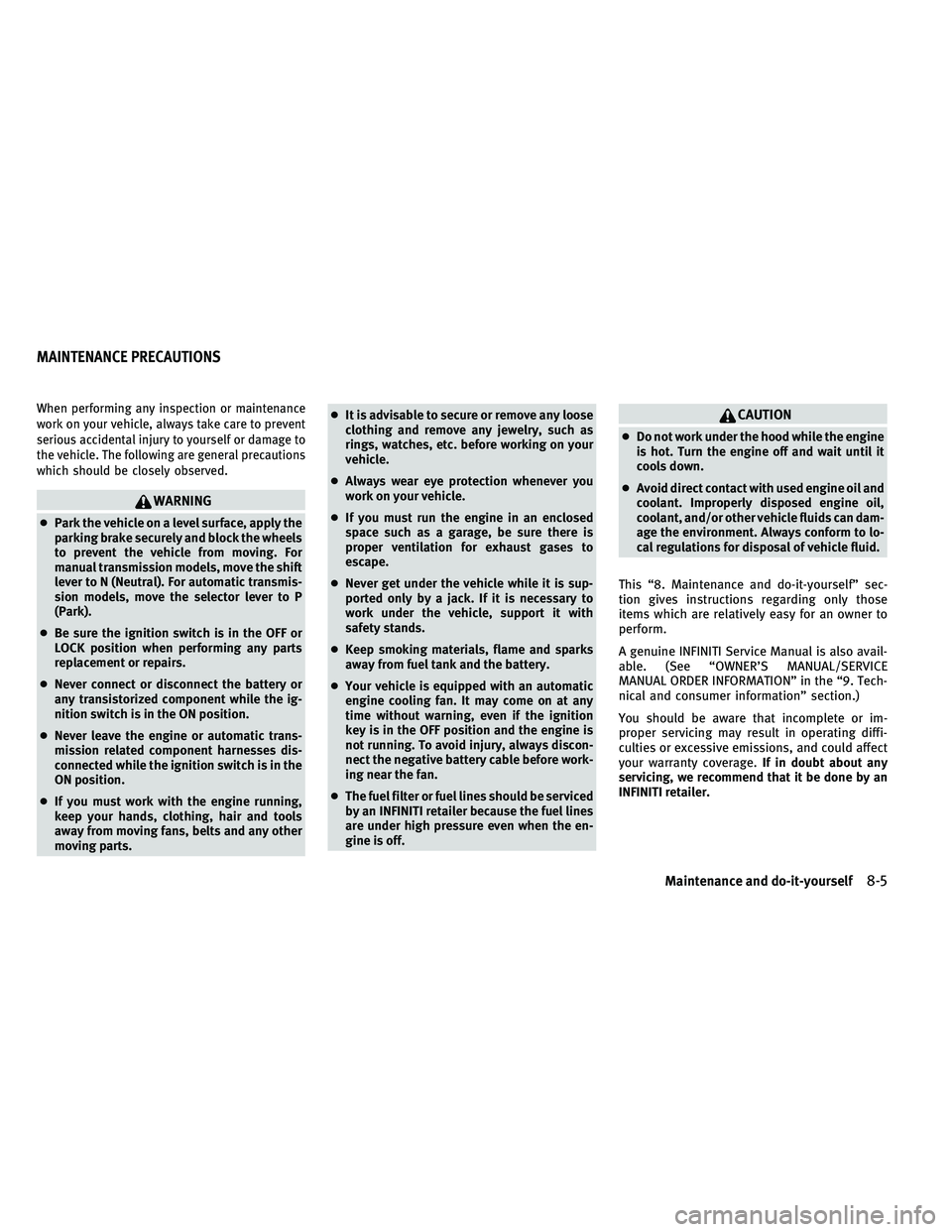
When performing any inspection or maintenance
work on your vehicle, always take care to prevent
serious accidental injury to yourself or damage to
the vehicle. The following are general precautions
which should be closely observed.
WARNING
●Park the vehicle on a level surface, apply the
parking brake securely and block the wheels
to prevent the vehicle from moving. For
manual transmission models, move the shift
lever to N (Neutral). For automatic transmis-
sion models, move the selector lever to P
(Park).
● Be sure the ignition switch is in the OFF or
LOCK position when performing any parts
replacement or repairs.
● Never connect or disconnect the battery or
any transistorized component while the ig-
nition switch is in the ON position.
● Never leave the engine or automatic trans-
mission related component harnesses dis-
connected while the ignition switch is in the
ON position.
● If you must work with the engine running,
keep your hands, clothing, hair and tools
away from moving fans, belts and any other
moving parts. ●
It is advisable to secure or remove any loose
clothing and remove any jewelry, such as
rings, watches, etc. before working on your
vehicle.
● Always wear eye protection whenever you
work on your vehicle.
● If you must run the engine in an enclosed
space such as a garage, be sure there is
proper ventilation for exhaust gases to
escape.
● Never get under the vehicle while it is sup-
ported only by a jack. If it is necessary to
work under the vehicle, support it with
safety stands.
● Keep smoking materials, flame and sparks
away from fuel tank and the battery.
● Your vehicle is equipped with an automatic
engine cooling fan. It may come on at any
time without warning, even if the ignition
key is in the OFF position and the engine is
not running. To avoid injury, always discon-
nect the negative battery cable before work-
ing near the fan.
● The fuel filter or fuel lines should be serviced
by an INFINITI retailer because the fuel lines
are under high pressure even when the en-
gine is off.
CAUTION
● Do not work under the hood while the engine
is hot. Turn the engine off and wait until it
cools down.
● Avoid direct contact with used engine oil and
coolant. Improperly disposed engine oil,
coolant, and/or other vehicle fluids can dam-
age the environment. Always conform to lo-
cal regulations for disposal of vehicle fluid.
This “8. Maintenance and do-it-yourself” sec-
tion gives instructions regarding only those
items which are relatively easy for an owner to
perform.
A genuine INFINITI Service Manual is also avail-
able. (See “OWNER’S MANUAL/SERVICE
MANUAL ORDER INFORMATION” in the “9. Tech-
nical and consumer information” section.)
You should be aware that incomplete or im-
proper servicing may result in operating diffi-
culties or excessive emissions, and could affect
your warranty coverage. If in doubt about any
servicing, we recommend that it be done by an
INFINITI retailer.
MAINTENANCE PRECAUTIONS
Maintenance and do-it-yourself8-5
Page 395 of 458

VQ37VHR ENGINE
1. Fuse/fusible link holder
2. Battery
3. Engine oil filler cap
4. Brake fluid reservoir5. Clutch fluid reservoir (Manual Transmis-
sion models)
6. Window washer fluid reservoir
7. Power steering fluid reservoir
8. Air cleaner 9. Radiator filler cap
10. Drive belt location
11. Engine coolant reservoir
12. Engine oil dipstick
SSI0345
ENGINE COMPARTMENT CHECK
LOCATIONS
8-6Maintenance and do-it-yourself